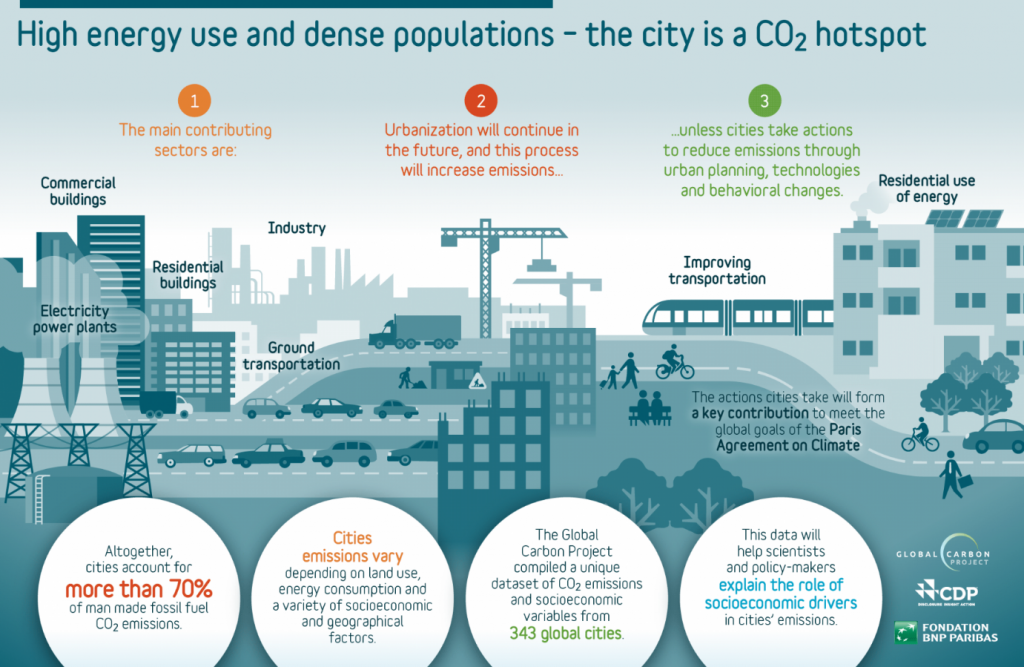Measuring CO2 Emissions of Cities with Sensor Networks
By Hannah M. Berman

Four ambitious goals have been set for this year’s COP26, with the ‘race’ to net-zero being at the forefront of the conference. This can be achieved through setting emissions reduction targets to keep global warming from reaching higher than 1.5℃. However, how do scientists and policy makers know how to set these targets and how do they know the methods to meet emission reduction targets are working? One such tool to answer these questions are CO2 sensor networks. The aim of my PhD project is to develop and implement a CO2 sensor network throughout the city of Leicester. This will have implications for policy, education, and public engagement. It will also allow more stringent measures to be taken in order to mitigate climate change. Finally, it will offer a novel insight into how cities and carbon interact, providing information on carbon cycles in cities. It is important to understand if there is any relationship with CO2 emissions of cities and the natural carbon cycle in order to understand how to mitigate emissions. Understanding the sources and sinks as well as fluxes could help determine action plans; it could allow local action as well as overarching policy measures to be taken. There is a correlation between CO2 emissions and air quality concerns and so this project will have an important implication for environmental and public health.
The carbon budget for 1.5℃ from the Global Carbon Project
CO2 Measurement Techniques
There are a number of earth observation science methods to measure greenhouse gas emissions, such as through remote sensing by satellite observations or in-situ measurements from ground-based tools. The focus of my research is on the use of carbon dioxide (CO2) sensors, an in-situ measurement tool, that can record concentration data in real-time. By creating a sensor network, a detailed picture can be drawn of an area’s greenhouse gas emissions. Not only do they track CO2, but they can also track other greenhouse gases and air pollutants such as carbon monoxide (CO), nitrogen oxide (NO), nitrogen dioxide (NO2), ozone (O3) and fine particulate matter (PM2.5). These sensors can have an impact on emissions data and also other air quality concerns such as public health and exposure to air pollutants.
BEACO2N
The sensors that I will use are made by the University of California-Berkeley and have been used to form the Berkeley Environmental Air-quality & CO2 Network (BEACO2N). The network started with a specific focus on cities in the Bay Area of California, USA, but has since expanded both nationally and internationally. The University of Strathclyde, partnered with BEACO2N, have implemented a sensor network in Glasgow to get a better understanding of the city’s emissions and the sensor data will be presented at the COP26. BEACO2N sensors are an effective low-cost tool and can make emissions monitoring more accessible to towns and cities across the world and hopefully, the demonstration of the BEACO2N sensor network could encourage more cities to install sensor networks of their own.
CO2 Emissions and Cities
It is important to get a better understanding of cities’ emissions because they contribute greatly to climate change, in fact over 70% of CO2 emissions stem from cities as seen in the figure.

Cities as a driver of CO2 emissions from the Global Carbon Project
CO2 makes up the largest share of radiative forcing of all greenhouse gas emissions. Radiative forcing is the heating of the atmosphere caused by greenhouse gas emissions. Human activity is responsible for the increased amount of greenhouse gases in the atmosphere and is one of the main drivers of climate change.
In the UK, data on CO2 emissions from cities are based on historic estimated consumption of fossil fuels such as for heating, power, and electricity, and are often only made available once a year. A sensor network could provide more detailed information on emissions and allow more informed policy decisions to be made. Crucially, they can also provide near immediate results to determine if mitigation measures are successful.
Next Steps
Sensor networks are an incredible tool not only for the scientific community, but also for public engagement and educational opportunities. BEACO2N is installed mostly on schools as it provides an educational opportunity for students to understand how emissions vary and help identify methods of limiting them. Sensor networks could be an important tool for developing cities across the globe, as they are accessible and affordable for cities to take action against air pollution and climate change. The sensor network I will install in Leicester will be up for at least a year to in order to get an accurate idea of emissions.
However, sensor networks are an incredible tool and can be used in a number of environments. There is potential for this network to be replicated in developing countries. Greenhouse gas emissions and the resulting effects have significant impact on environmental and public health and it is often developing countries that endure the most of this. Urban areas host a substantial amount of the population of developing countries and so it is important for them to have the tools and resources to mitigate emissions and climate change. Many developing countries have also set forth emissions reduction targets and so these sensors could be a useful resource in meeting these targets. Overall, they offer an in-depth look at emissions and can help with management techniques; as W. Edward Deming said: “you can’t manage what you don’t measure”.
Hannah M. Berman is a 2nd year PhD student at University of Leicester.